牛津译林版英语七年级上册《My day》Reading
- 格式:pptx
- 大小:1.75 MB
- 文档页数:15
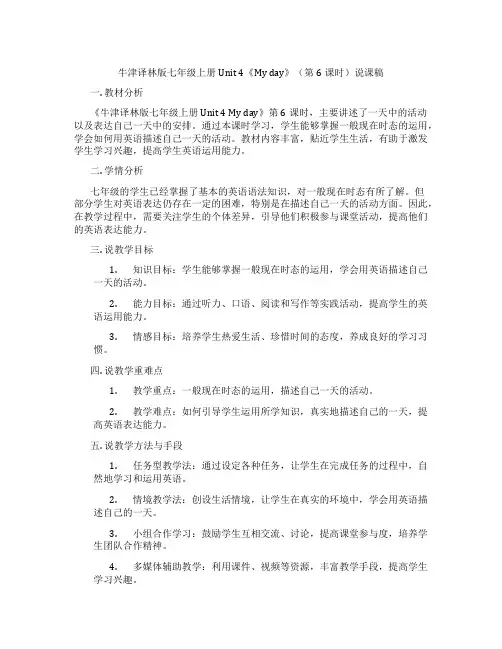
牛津译林版七年级上册Unit 4《My day》(第6课时)说课稿一. 教材分析《牛津译林版七年级上册Unit 4 My day》第6课时,主要讲述了一天中的活动以及表达自己一天中的安排。
通过本课时学习,学生能够掌握一般现在时态的运用,学会如何用英语描述自己一天的活动。
教材内容丰富,贴近学生生活,有助于激发学生学习兴趣,提高学生英语运用能力。
二. 学情分析七年级的学生已经掌握了基本的英语语法知识,对一般现在时态有所了解。
但部分学生对英语表达仍存在一定的困难,特别是在描述自己一天的活动方面。
因此,在教学过程中,需要关注学生的个体差异,引导他们积极参与课堂活动,提高他们的英语表达能力。
三. 说教学目标1.知识目标:学生能够掌握一般现在时态的运用,学会用英语描述自己一天的活动。
2.能力目标:通过听力、口语、阅读和写作等实践活动,提高学生的英语运用能力。
3.情感目标:培养学生热爱生活、珍惜时间的态度,养成良好的学习习惯。
四. 说教学重难点1.教学重点:一般现在时态的运用,描述自己一天的活动。
2.教学难点:如何引导学生运用所学知识,真实地描述自己的一天,提高英语表达能力。
五. 说教学方法与手段1.任务型教学法:通过设定各种任务,让学生在完成任务的过程中,自然地学习和运用英语。
2.情境教学法:创设生活情境,让学生在真实的环境中,学会用英语描述自己的一天。
3.小组合作学习:鼓励学生互相交流、讨论,提高课堂参与度,培养学生团队合作精神。
4.多媒体辅助教学:利用课件、视频等资源,丰富教学手段,提高学生学习兴趣。
1.热身(5分钟):通过提问学生一天的活动,引导学生回顾已学知识,为新课学习做好铺垫。
2.呈现(10分钟):利用课件展示一天的活动图片,引导学生用英语描述图片内容,引出本课主题。
3.任务型学习(15分钟):学生分组,每组完成一个描述自己一天活动的任务,如制作海报、编写故事等。
4.口语练习(10分钟):学生模拟情景,用英语描述自己的一天,培养口语表达能力。
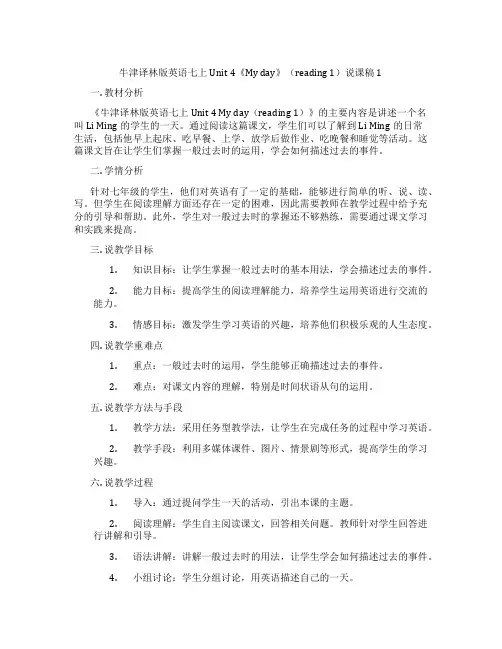
牛津译林版英语七上Unit 4《My day》(reading 1)说课稿1一. 教材分析《牛津译林版英语七上Unit 4 My day(reading 1)》的主要内容是讲述一个名叫Li Ming的学生的一天。
通过阅读这篇课文,学生们可以了解到Li Ming的日常生活,包括他早上起床、吃早餐、上学、放学后做作业、吃晚餐和睡觉等活动。
这篇课文旨在让学生们掌握一般过去时的运用,学会如何描述过去的事件。
二. 学情分析针对七年级的学生,他们对英语有了一定的基础,能够进行简单的听、说、读、写。
但学生在阅读理解方面还存在一定的困难,因此需要教师在教学过程中给予充分的引导和帮助。
此外,学生对一般过去时的掌握还不够熟练,需要通过课文学习和实践来提高。
三. 说教学目标1.知识目标:让学生掌握一般过去时的基本用法,学会描述过去的事件。
2.能力目标:提高学生的阅读理解能力,培养学生运用英语进行交流的能力。
3.情感目标:激发学生学习英语的兴趣,培养他们积极乐观的人生态度。
四. 说教学重难点1.重点:一般过去时的运用,学生能够正确描述过去的事件。
2.难点:对课文内容的理解,特别是时间状语从句的运用。
五. 说教学方法与手段1.教学方法:采用任务型教学法,让学生在完成任务的过程中学习英语。
2.教学手段:利用多媒体课件、图片、情景剧等形式,提高学生的学习兴趣。
六. 说教学过程1.导入:通过提问学生一天的活动,引出本课的主题。
2.阅读理解:学生自主阅读课文,回答相关问题。
教师针对学生回答进行讲解和引导。
3.语法讲解:讲解一般过去时的用法,让学生学会如何描述过去的事件。
4.小组讨论:学生分组讨论,用英语描述自己的一天。
5.情景剧表演:学生分组表演情景剧,运用一般过去时描述角色的一天。
6.总结:教师对本节课的内容进行总结,强调一般过去时的运用。
7.作业布置:让学生写一篇关于自己一天的英语作文。
七. 说板书设计板书设计如下:1.一般过去时:过去的时间 + 动词过去式2.时间状语从句:when, after, before, while3.描述过去事件的步骤:a.确定时间b.描述活动c.表达感受八. 说教学评价1.课堂参与度:观察学生在课堂上的积极参与情况,包括回答问题、小组讨论等。
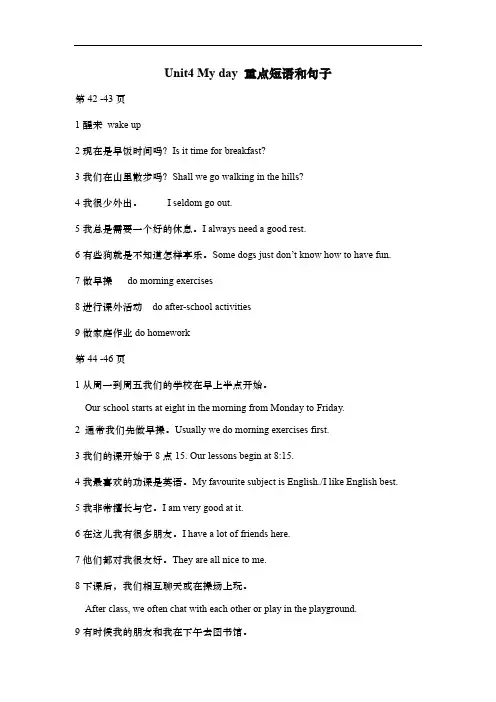
Unit4 My day 重点短语和句子第42 -43页1醒来wake up2现在是早饭时间吗?Is it time for breakfast?3我们在山里散步吗?Shall we go walking in the hills?4我很少外出。
I seldom go out.5我总是需要一个好的休息。
I always need a good rest.6有些狗就是不知道怎样享乐。
Some dogs just don’t know how to have fun. 7做早操do morning exercises8进行课外活动do after-school activities9做家庭作业do homework第44 -46页1从周一到周五我们的学校在早上半点开始。
Our school starts at eight in the morning from Monday to Friday.2 通常我们先做早操。
Usually we do morning exercises first.3我们的课开始于8点15. Our lessons begin at 8:15.4我最喜欢的功课是英语。
My favourite subject is English./I like English best. 5我非常擅长与它。
I am very good at it.6在这儿我有很多朋友。
I have a lot of friends here.7他们都对我很友好。
They are all nice to me.8下课后,我们相互聊天或在操场上玩。
After class, we often chat with each other or play in the playground.9有时候我的朋友和我在下午去图书馆。
Sometimes my friends and I go to the library in the afternoon.10我们有一个阅读俱乐部。
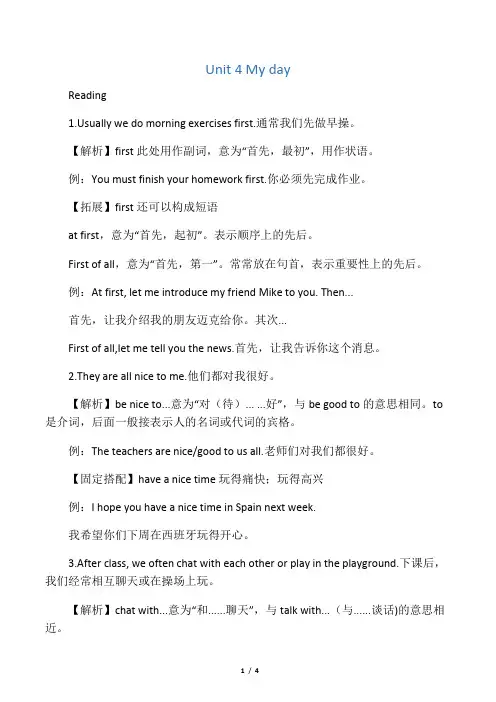
Unit 4 My dayReadingually we do morning exercises first.通常我们先做早操。
【解析】first此处用作副词,意为“首先,最初”,用作状语。
例:You must finish your homework first.你必须先完成作业。
【拓展】first还可以构成短语at first,意为“首先,起初”。
表示顺序上的先后。
First of all,意为“首先,第一”。
常常放在句首,表示重要性上的先后。
例:At first, let me introduce my friend Mike to you. Then...首先,让我介绍我的朋友迈克给你。
其次...First of all,let me tell you the news.首先,让我告诉你这个消息。
2.They are all nice to me.他们都对我很好。
【解析】be nice to...意为“对(待)... ...好”,与be good to的意思相同。
to 是介词,后面一般接表示人的名词或代词的宾格。
例:The teachers are nice/good to us all.老师们对我们都很好。
【固定搭配】have a nice time玩得痛快;玩得高兴例:I hope you have a nice time in Spain next week.我希望你们下周在西班牙玩得开心。
3.After class, we often chat with each other or play in the playground.下课后,我们经常相互聊天或在操场上玩。
【解析】chat with...意为“和......聊天”,与talk with...(与......谈话)的意思相近。
例:Do you often chat with your friends?你经常和你的朋友们聊天吗?【解析】each other相当于代词,表示相互关系,意为“互相,彼此”。

牛津译林版英语七上Unit 4《My day》(Grammar)说课稿一. 教材分析《牛津译林版英语七上Unit 4 My day》主要讲述了日常生活中的活动安排和描述。
通过本单元的学习,学生能够掌握一般现在时态的运用,学会如何用英语描述自己的日常活动。
本单元的核心语法是一般现在时,学生需要掌握其构成、用法以及与一般过去时和一般将来时的区别。
二. 学情分析七年级的学生已经初步掌握了英语的基础知识,具备一定的听、说、读、写能力。
但在此阶段,学生对英语的语法知识掌握还不够深入,需要通过大量的练习来巩固。
此外,学生的学习兴趣和积极性对英语学习成果有很大影响,因此,激发学生的学习兴趣和动机是本节课的重要任务。
三. 说教学目标1.知识目标:学生能够掌握一般现在时的构成、用法,学会用英语描述自己的日常活动。
2.能力目标:学生能够在实际情景中运用一般现在时,提高英语表达能力。
3.情感目标:培养学生热爱生活、积极向上的生活态度,增强同学间的友谊。
四. 说教学重难点1.教学重点:一般现在时的构成、用法以及与一般过去时、一般将来时的区别。
2.教学难点:一般现在时的运用,特别是在具体情境中的运用。
五. 说教学方法与手段本节课采用任务型教学法,通过各种互动活动,让学生在实际操作中掌握一般现在时的用法。
同时,运用多媒体手段,如图片、视频等,辅助教学,提高学生的学习兴趣。
六. 说教学过程1.导入:以一幅描绘日常活动的图片引导学生进行观察,激发学生对课程的兴趣。
2.呈现:通过展示一段视频,让学生了解一般现在时的用法,同时引入本节课的主题。
3.操练:设计各种任务,让学生在实际操作中运用一般现在时,如描述自己的日常活动、编写对话等。
4.巩固:通过小组活动,让学生在互动中进一步巩固一般现在时的用法。
5.拓展:引导学生运用一般现在时描述未来的计划,培养学生的创新思维。
6.总结:对本节课的内容进行归纳总结,强调一般现在时的用法。
7.作业:布置相关练习,让学生课后巩固所学知识。
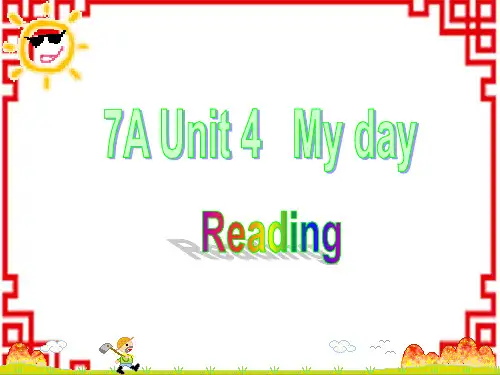
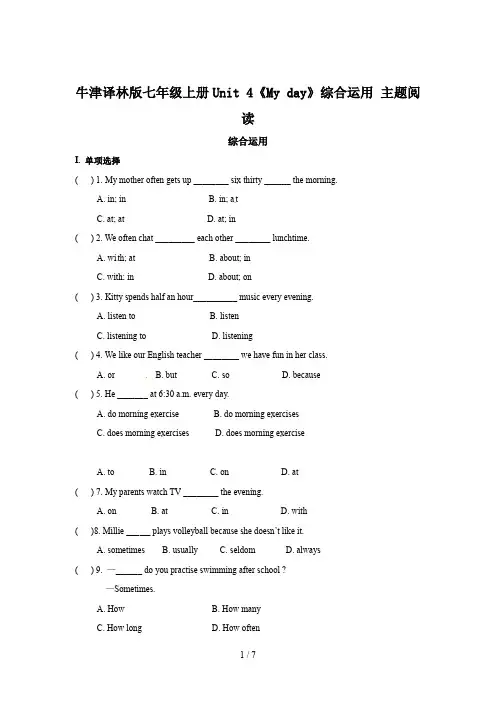
牛津译林版七年级上册Unit 4《My day》综合运用主题阅读综合运用I. 单项选择( ) 1. My mother often gets up ________ six thirty ______ the morning.A. in; inB. in; a tC. at; atD. at; in( ) 2. We often chat _________ each other ________ lunchtime.A. wi th; atB. about; inC. with; inD. about; on( ) 3. Kitty spends half an hour__________ music every evening.A. listen toB. listenC. listening toD. listening( ) 4. We like our English teacher ________ we have fun in her class.A. orB. butC. soD. because( ) 5. He _______ at 6:30 a.m. every day.A. do morning exerciseB. do morning exercisesC. does morning exercisesD. does morning exerciseA. toB. inC. onD. at( ) 7. My parents watch TV ________ the evening.A. onB. atC. inD. with( )8. Millie ___ __ plays volleyball because she doesn’t like it.A. sometimesB. usuallyC. seldomD. always( ) 9. —______ do you practise swimming after school ?—Sometimes.A. HowB. How manyC. How longD. How often( ) 10. He is very busy. He has no time ______ with his friends.A. chatB. chattingC. to chatD. chats ( ) 11. It’s time ______ class. Listen ________ the teacher.A. to; toB. of; withC. for; afterD. for; to ( ) 12. Do you know the answer __________ the question?A. toB. ofC. atD. in ( ) 13. Lily hates fish. She _______ eats it.A. neverB. alwaysC. usuallyD. often ( )14. —May I borrow your CD player?—________.A. I don’t have oneB. I am sorry. I don’t knowC. Sorry, I don’t hav e oneD. Yes, I do( ) 15. Shall we _______ walking in the hill?A. goingB. goC. to goD. is goingII. 句型转换(改为一般疑问句,并作否定回答)_________________________________________________2. They do morning exercises every day. (改为否定句)_________________________________________________3. I like my classroom because it is big and clean. (对划线部分提问)_________________________________________________lie goes to the Reading Club twice a week. (对划线部分提问)_________________________________________________5. Kitty helps Amy and Amy helps Kitty too. (改为同义句)_________________________________________________6. It takes me half a day to make this model plane. (改为同义句)_________________________________________________7. He seldom takes a taxi to go to school. (对划线部分提问)_________________________________________________8. We play badminton for half an hour every day.( 对划线部分提问) _________________________________________________9. He likes playing volleyball very much. (改为一般疑问句)_________________________________________________10. We have the football match once a month. (对划线部分提问)_________________________________________________III. 根据所给汉语完成句子1. 请明天早上6点钟叫醒我。
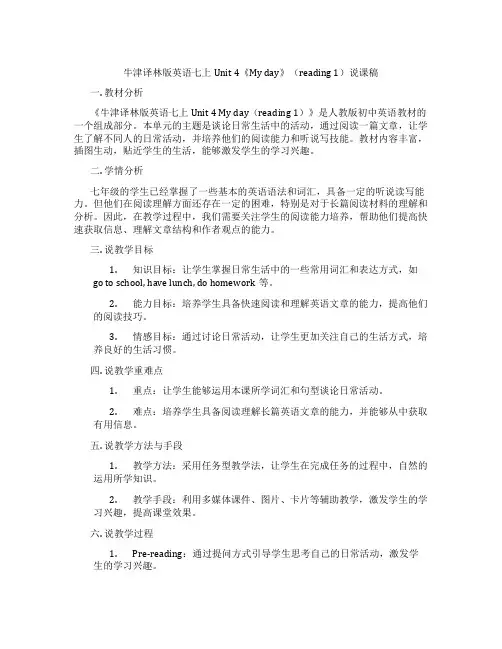
牛津译林版英语七上Unit 4《My day》(reading 1)说课稿一. 教材分析《牛津译林版英语七上Unit 4 My day(reading 1)》是人教版初中英语教材的一个组成部分。
本单元的主题是谈论日常生活中的活动,通过阅读一篇文章,让学生了解不同人的日常活动,并培养他们的阅读能力和听说写技能。
教材内容丰富,插图生动,贴近学生的生活,能够激发学生的学习兴趣。
二. 学情分析七年级的学生已经掌握了一些基本的英语语法和词汇,具备一定的听说读写能力。
但他们在阅读理解方面还存在一定的困难,特别是对于长篇阅读材料的理解和分析。
因此,在教学过程中,我们需要关注学生的阅读能力培养,帮助他们提高快速获取信息、理解文章结构和作者观点的能力。
三. 说教学目标1.知识目标:让学生掌握日常生活中的一些常用词汇和表达方式,如go to school, have lunch, do homework等。
2.能力目标:培养学生具备快速阅读和理解英语文章的能力,提高他们的阅读技巧。
3.情感目标:通过讨论日常活动,让学生更加关注自己的生活方式,培养良好的生活习惯。
四. 说教学重难点1.重点:让学生能够运用本课所学词汇和句型谈论日常活动。
2.难点:培养学生具备阅读理解长篇英语文章的能力,并能够从中获取有用信息。
五. 说教学方法与手段1.教学方法:采用任务型教学法,让学生在完成任务的过程中,自然的运用所学知识。
2.教学手段:利用多媒体课件、图片、卡片等辅助教学,激发学生的学习兴趣,提高课堂效果。
六. 说教学过程1.Pre-reading:通过提问方式引导学生思考自己的日常活动,激发学生的学习兴趣。
2.While-reading:让学生快速阅读文章,回答问题,培养他们的阅读理解能力。
引导学生关注文章结构和作者观点,提高他们的阅读技巧。
3.Post-reading:让学生进行小组讨论,分享自己的日常活动,培养他们的口语表达能力。
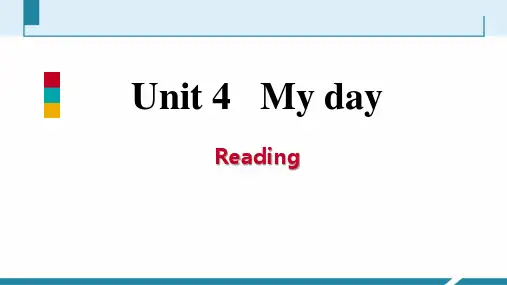
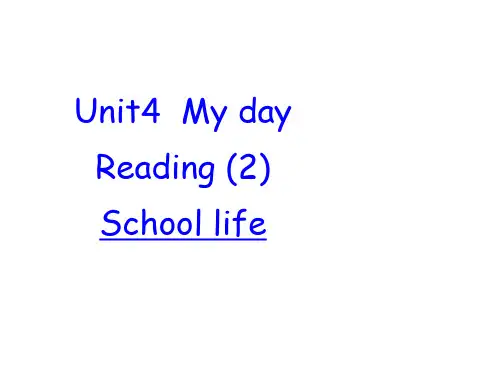
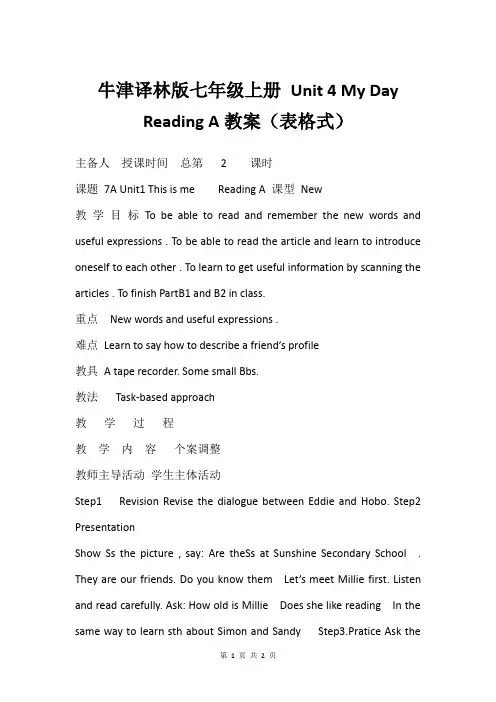
牛津译林版七年级上册Unit 4 My DayReading A教案(表格式)主备人授课时间总第 2 课时课题7A Unit1 This is me Reading A 课型New教学目标To be able to read and remember the new words and useful expressions . To be able to read the article and learn to introduce oneself to each other . To learn to get useful information by scanning the articles . To finish PartB1 and B2 in class.重点New words and useful expressions .难点Learn to say how to describe a friend’s profile教具A tape recorder. Some small Bbs.教法Task-based approach教学过程教学内容个案调整教师主导活动学生主体活动Step1 Revision Revise the dialogue between Eddie and Hobo. Step2 PresentationShow Ss the picture , say: Are theSs at Sunshine Secondary School . They are our friends. Do you know them Let’s meet Millie first. Listen and read carefully. Ask: How old is Millie Does she like reading In the same way to learn sth about Simon and Sandy Step3.Pratice Ask theSs to read again and finish Part B on Page 9 and Part C on Page 10. Ask: What activities do his Look and answer. Look and learn carefully. Answer the questions Think of the ercises.教学过程教学内容个案调整教师主导活动学生主体活动Step4.Discussion students like Please help him to put the correct letters in the box. 1.Ask the Ss to finish Part B2, discuss the answers with the Ss Step5 composition 2 Learn the language points. We know something about Millie ,Simon, Kitty, Amy, Sandy and Daniel now. Do you know more about them Let's do the following exercises. Step6 Homework Finish the exercises in the workbook. Revise the use of the Prep. in English. Do the exercises in the Part C1 do the test paper.板书设计7A Unit 1 Reading I Ⅰ.Words: Ⅰ.Notes: She is good at swimming . He likes playing computer games . He wears glasses .教学札记。
38 牛津译林版七年级英语上册牛津译林版七年级英语上册Periods :031Date : : Prepare – Oct.15th Title : Unit 4 My day Comic strip & Welcome to the unitTeaching aims: Students can master the following in this class.1.words :wake shall seldom activity quarter2.phrases :wake up, go out, do after-school activities, do homework, have fun,be late for , go to bed 3.sentences :I seldom go out .I’m never late for it .At a quarter past eight . Difficult points:Words about daily life .Students can use the words and sentences learned in this class to describe daily life .Procedures :Step1 Free talkLead-inT: What time does your school day begin ?S: It begins at 6:45.T: Oh, it starts at 6:45. You start our school day at 6:45. So you need to wake up very early. (teach wake up and start )Show some pictures of clock.T: It is six o ’clock in the morning. What does ….do? Can you guess ?(Teach have breakfast /have lunch /have dinner; need; rest ;go out ; have fun )Step2 PracticeT: Hobo wants to know something about you. He would like to ask the questions below. Please answer them.(1) What time do you wake up?(2) Do you often go out to play games /have dinner .have fun ?(3) Do you often have breakfast ?(4) Where do you have lunch ?(5) Do you always have a rest after lunch?According to the students ’ answers, present “seldom ”and “never ”at the right time.Step3 PresentationT: Do you remember our friend Eddie ? What does he do every day? Can you guess ?Now let’s listen to the conversation between Eddie and Hobo and check if you are right. (Teach hill )T: What does Hobo think of dogs like Eddie ?Step 4 PracticePractise the conversation and act it out.Step 5 ExtentionHere’s Hobo ’s diary. Please help him complete it.It is sunny today. I would like to go________. I like sports and I always go walking in the ____________. But my friend Eddie is lazy. He ___________does sports. He _________up very late.And then he wants to have __________. After it, he sleeps again. When he finishes his lunch, he says he ________a good _______ once more.Oh, my God ! His life is eating and sleeping. I think some dogs ________don’t know how to have____________.Step 6 PresentationT: Do you want to be lazy like Eddie? What time do you wake up every morning ? What time do you have breakfast / lunch / dinner /every day ? Why do you get up so early ?(Teach quarter, past, get up and be late for, have lessons/have classes. do after-school activities, do homework, go to bed …)Step 7 PractiseLook at the table of Millie’s day. Answer some questions.Look at the times on the blackboard. Please tell me your activities at these times.6:30 a.m 7:00 a.m 8:00 a.m 11:50 a.m4:30 p.m 6:00 p.m 8:00p.m 9:00 p.mMake sentences with “I _________________ at_____________.”Step 8 PresentationPart BT: Millie is busy every day. Now, she is telling her aunt about her school life. Let’s listen to their conversation and answer my question: Is Millie often late for school ?S: No. She is never late for school.T: Millie is a good student. She is never late for school. What about you? Are you often late for school? Are you never late for school?Step 9 PractiseRead Part B and practice it .T: Are your daily activities the same as Millie’s ? Now, you can complete the table on the right with your own information.…….T: Now time for you. I’d like you to work in groups of four to discuss your own day. You can use Millie and her aunt’s conversation as a model.Homework :1. Learn the new words by heart.2.Finish the exercisesAfterthoughts :Periods :032-033Date : : Prepare – Oct.15thTitle: Unit 4 My day ReadingTeaching aims:1. Students can master new words and expressions.2. Students can learn some new phrases: chat with best wishes have a good time3. Students can learn some new sentences:Our school starts at eight in the morning from Monday to Friday.Usually we do morning exercises first.Procedures :Step1 Free talk1.Do you have a full(充实的)充实的) and busy day?2.What do you usually do every day?Step2 PresentationListen to the passage and choose a title for this e-mail.Step3 ScaningRead the passage quickly and silently and do “T” or “F” questions in pairs.(partB2)Setp4 SkimmingRead the article again and do more exercises. (partB1)Step5 RetellingRetell Millie’s school life . Fill in the blanks.( partB3)Step6 Language pointsSome language points :a lot of = lots ofSometimes , some times , sometime , some timehave a good timeHomework :1. Learn the new words by heart.2.Finish off the exercises.Afterthoughts :Periods :034-035Date : : Prepare – Oct.18thTitle: Unit 4 My day GrammarTeaching aims:1. Students can use the prepositions correctly.2. Students can use the adverbs of frequency correctly.Difficult points: the usage of the prepositionsProcedures :Step1 Presentation1. Free talk .Use some questions to lead the usage of the prepositions .eg: What time do you go to school?When is your birthday?2. P47表格,教师归纳总结,领读例句。
Unit 4 My dayReading (II)I. Teaching aims and learning objectivesBy the end of the lesson, students should be able to:1. talk about Millie’s school life in form of a dialogue;2. retell Millie’s school life in third person according to the pictures;3. talk about th eir own or others’ school life.II. Teaching contents1. New expressions: in the morning/afternoon/evening, each other, have a good time, chat with, best wishes2. Structures: Our school starts at eight in the morning from Monday to Friday. Usually we do morning exercises first.We practice after school on Wednesday.We always have a good time at school.We often chat with each other.III. Focus of the lesson and predicted area of difficulty1. Understand the useful expressions and sentence structures;2. Retell Millie’s school life in the third person;3. Use proper expressions and sentence structures to describe their own school life. IV. Teaching proceduresStep 1 Lead-inFree talkT: Hi guys! Do you know the girl in the picture? Who’s she? Which school does she study in? Doe s she love her school? Wow, it seems that you know Millie very well.I want to know something about her school life. Can you help me? Please ask and answer my following questions in pairs. (Students talk about the questions according to the information they’ve got from Reading I)(1) What does she do at school in the morning?(2) What time do they begin to have lessons?(3) What’s her favourite subject?(4) Does she have any friends at school?(5) What do they do after class?(6) Do they have many lessons in the afternoon?(7) What do they often do in the afternoon?(8) How does Millie like her school?【设计意图:通过Reading I的师生问答导入新课,针对Millie’s school life的学生间互问互答,帮助学生回忆并再现文本信息,以开展后续的相关学习。
牛津译林版英语七上Unit 4《My day》(reading 1)教学设计一. 教材分析牛津译林版英语七上Unit 4《My day》(reading 1)主要介绍了主人公LiMing的日常生活。
通过描述他每天的活动,文章旨在帮助学生理解一般过去时的用法,并学会如何用英语描述过去的一天。
本课内容与学生的日常生活紧密相连,易于引起学生的兴趣和共鸣。
二. 学情分析七年级的学生已经掌握了基本的英语语法和词汇,具备一定的听说读写能力。
但他们在使用英语描述过去事件时,可能还存在一定的困难。
因此,在教学过程中,教师需要关注学生的个体差异,充分调动他们的积极性,引导他们正确运用一般过去时描述过去的事件。
三. 教学目标1.知识目标:–学会正确使用一般过去时描述过去的事件。
–掌握关键词汇和短语,如:go to school, have lunch, do homework等。
2.能力目标:–提高学生的阅读理解能力,能够理解并描述主人公Li Ming的日常生活。
–提高学生的口语表达和写作能力,能够用英语描述自己的日常生活。
3.情感目标:–培养学生对英语学习的兴趣,增强自信心。
–培养学生热爱生活,养成良好的生活习惯。
四. 教学重难点•一般过去时的用法。
•描述过去事件的表达方式。
•正确运用一般过去时描述过去的事件。
•灵活运用关键词汇和短语。
五. 教学方法1.情境教学法:通过设定生活情境,让学生在实际语境中学习并运用英语。
2.任务型教学法:通过完成各种任务,提高学生的阅读、口语和写作能力。
3.小组合作学习:培养学生团队合作精神,激发学习兴趣。
六. 教学准备1.教学材料:教材、多媒体课件、黑板、粉笔。
2.教学工具:投影仪、计算机、音响设备。
七. 教学过程1.导入(5分钟)教师通过提问方式引导学生回顾一般过去时的用法,如:“What did you do yesterday?”,激发学生的学习兴趣。
2.呈现(10分钟)教师播放课文录音,让学生初步感知文章内容。